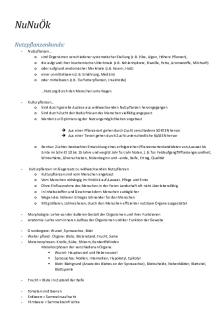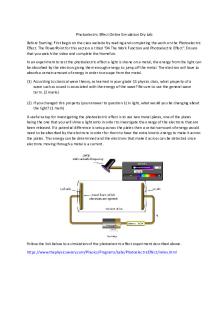Millie Larsen Online Simulation 1 NU 307 PDF

| Title | Millie Larsen Online Simulation 1 NU 307 |
|---|---|
| Author | Jason Le |
| Course | MedSurge |
| Institution | Marymount University |
| Pages | 3 |
| File Size | 118.5 KB |
| File Type | |
| Total Downloads | 90 |
| Total Views | 128 |
Summary
this is coursework for nu 307 medical surgical. Use this as a guide instead of copying it word by word. good lucks guys!...
Description
Millie Larsen, Part 1 Guided Reflection Questions Opening Questions How did the simulated experience of Millie Larsen’s case make you feel? The simulation made me feel important in providing care for Millie Larsen because her blood pressure was extremely elevated, and I had to notify her primary care provider to resolve the issue.
What nursing actions did you feel were appropriate within this scenario? I felt that the assessment of the patient, interpersonal communication, administration of medication, and patient/family education provided were important and appropriate nursing actions for the scenario.
Scenario Analysis Questions* EBP What findings indicate the cause(s) of Millie Larsen’s confusion? How do these findings do so? o
o
EBP
Lab diagnostics Elevated sodium (hypernatremia) indicate that the patient is dehydrated which can cause confusion Decreased potassium (hypokalemia) indicate that the patient is dehydrated which can cause confusion Elevated WBC count in blood which indicates the presence of infection, and infection, especially UTI, can cause confusion in older adults Decreased hemoglobin levels due to infection, and infection, especially UTI, can cause confusion in older adults Urine is dark/amber/cloudy which indicates dehydration which can cause confusion Elevated WBC in urine which indicates infection, and infection, especially UTI, can cause confusion in older adults Elevated RBC in urine which indicates infection, and infection, especially UTI, can cause confusion in older adults Elevated specific gravity of urine indicates dehydration which can cause confusion Intake/output I & O shows decreased urine output which indicates dehydration which can cause confusion
What potential problems can you identify for Millie Larsen?
Millie Larsen is currently at risk for falls, however if she allows herself to become dehydrated in the future she can once again experience urinary tract infections. This can cause her to enter a state of confusion that causes her to improperly use her medication and
From vSim for Nursing | Gerontology. © Wolters Kluwer Health.
increase her risk for falls. This can lead to cardiovascular problems as well as trauma and injury if she is unable to ambulate without falling.
PCC
What communication techniques could be used to improve Millie Larsen’s situation? Active listening and seeking clarification will be important for Millie Larsen’s situation because she is currently in a state of confusion where she is unable to speak clearly, so it is important to use these techniques when addressing her daughter for further information. Placing events in a time sequence will also be important in understanding what events led to Millie Larsen being admitted into the hospital, but also improved communication between Millie Larsen and her daughter could be necessary to prevent her from becoming dehydrated to the point of developing a urinary tract infection and becoming confused.
S/QI
For the following Safety/Quality Improvement measures, what nursing actions should be taken during Millie Larsen’s case?
Safety/Quality Improvement Measures Medication administration to include drug calculations
Patient/family teaching and assisting in care delivery
Equipment use
T&C
Nursing Actions -assess patient before administering medication, adhere to 6 medication rights, avoid distractions when preparing medications, carefully convert units for drug calculations if necessary, always clarify order if unclear or unusual, use available technology to administer medications, understand administration frequency of ordered medication -educate patient/family on disorder, diagnostic testing, and treatment of UTI, preventative measures, importance on increasing fluid intake, signs and symptoms of reoccurrence, comfort measures such as warm sitz baths and compresses over the bladder, proper perineal hygiene measures, importance of completing full course of prescribed drug therapy, safety risks associated with dehydration such as falls and confusion/disorientation, importance of proper medication use, asses patient/family’s understanding of teaching -use only clean equipment, use assistive devices for ambulation if needed, properly use side rails to prevent patient from falling
Why was it important to include Dina, Millie Larsen’s daughter, as a member of the health care team? It is important to include Dina, Millie Larsen’s daughter, as a member of the health care team because Dina is her mother’s closest person of contact, and she needs to be educated and aware of her mother’s condition so that she can take care of her. Dina is also responsible for answering important assessment questions for her mother when her mother is unable to. By including Dina, she will know the importance of monitoring and ensuring that her mother is staying hydrated, taking her medicine, and maintaining her health.
From vSim for Nursing | Gerontology. © Wolters Kluwer Health.
Concluding Questions Reflecting on Millie Larsen’s case, were there any actions you would do differently? If so, what were these actions, and why would you do them differently? I do not think I would do anything differently regarding Millie’s Larsen’s case because the assessment and interpersonal communication with her primary care provider involved specific time and action sequences that were important to providing optimal care for her.
How would you apply the knowledge and skills that you obtained in Millie Larsen’s case to an actual patient care situation? By completing this simulation I further learned about the importance of interpersonal communication as well as the importance of the SBAR tool, and I can use this knowledge during an actual patient care situation if the patient’s status meets the criteria of a call order or if I observe something abnormal. I also got to experience providing care for a patient who disoriented and has impaired memory, and it taught me how to communicate with a family member and I feel that I will experience this many times as a nurse.
*The Scenario Analysis Questions are correlated to the Quality and Safety Education for Nurses (QSEN) competencies: Patient-Centered Care (PCC), Teamwork and Collaboration (T&C), Evidence-Based Practice (EBP), Quality Improvement (QI), Safety (S), and Informatics (I). Find more information at: http://qsen.org/
From vSim for Nursing | Gerontology. © Wolters Kluwer Health....
Similar Free PDFs

Zusammenfassung Nu Nu Ök
- 36 Pages

BUS 307- Case Study 1
- 7 Pages

Efecto Larsen
- 4 Pages

TMC501 Simulation 1
- 2 Pages

MGT 307 SET-3
- 8 Pages

BUAD 307 Syllabus
- 18 Pages

Bsbadm 307 – Organise Schedules
- 8 Pages
Popular Institutions
- Tinajero National High School - Annex
- Politeknik Caltex Riau
- Yokohama City University
- SGT University
- University of Al-Qadisiyah
- Divine Word College of Vigan
- Techniek College Rotterdam
- Universidade de Santiago
- Universiti Teknologi MARA Cawangan Johor Kampus Pasir Gudang
- Poltekkes Kemenkes Yogyakarta
- Baguio City National High School
- Colegio san marcos
- preparatoria uno
- Centro de Bachillerato Tecnológico Industrial y de Servicios No. 107
- Dalian Maritime University
- Quang Trung Secondary School
- Colegio Tecnológico en Informática
- Corporación Regional de Educación Superior
- Grupo CEDVA
- Dar Al Uloom University
- Centro de Estudios Preuniversitarios de la Universidad Nacional de Ingeniería
- 上智大学
- Aakash International School, Nuna Majara
- San Felipe Neri Catholic School
- Kang Chiao International School - New Taipei City
- Misamis Occidental National High School
- Institución Educativa Escuela Normal Juan Ladrilleros
- Kolehiyo ng Pantukan
- Batanes State College
- Instituto Continental
- Sekolah Menengah Kejuruan Kesehatan Kaltara (Tarakan)
- Colegio de La Inmaculada Concepcion - Cebu








